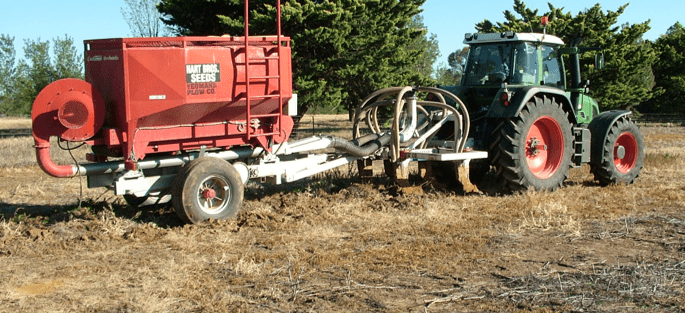
Ripping and injection under way during the trials at Culcairn, NSW. Photo: Dr Mark Conyers
NEW results from a three-year Australian field trial have raised questions around a recommended soil amendment practice, with deep tillage and injecting limestone into soil both failing to produce significant grain-yield responses in the canola-cereal sequence.
Veteran soil scientist Mark Conyers led a group of CSIRO and Charles Sturt University researchers investigating ways to overcome a hardpan and subsurface acidity.
They combined deep ripping and dry-limestone injection to depth of 30cm to test a hypothesis that amending subsurface acidity and compaction would increased grain yields.
“Limitations to crop yield have been frequently reported on the non-sodic soils of south-eastern Australia,” Dr Conyers said.
“These have been attributed to subsurface compaction layers at between five and 15cm, along with subsurface acidity of less than pH4.8.”
Current costings for DIY deep ripping range from $100/ha to $200/ha, with landed lime prices additional, as well as fuel, time, equipment and labour costs.
Previous studies have advocated both these amendments for compacted soils.
It is advice that is still shared.
The Grains Research and Development Corporation website states: “Deep ripping is most likely to improve grain yields on sandy soils where upper parts of the soil profile have been compacted by machinery traffic.
“Deep ripping is less effective on heavy clay soils which appears related to subsoil constraints.
“On clay soils with subsoil constraints, the application of ameliorants such as gypsum and organic matter in combination with deep ripping can often result in yield improvements.”
The Western Australian Department of Primary Industries and Regional Development website also endorses the practice, saying: “Deep ripping uses strong tines working down to 35-50cm depth to loosen hard layers of soil.”
Dr Conyers said the practice has not been proven for all of Australia’s cropping country.
“Amendment studies in south-eastern Australia on non-sodic loam soils have been few and inconsistent in the extent and longevity of any response,” Dr Conyers said.
His team of researchers used a Yeomans ripper and injector on a 1ha site east of Culcairn in southern NSW on yellow kandosol.
Their study reported that, for all three years, the soil strength was reduced and the pH of subsurface layers increased.
“Early vegetative growth sometimes responded to the treatments, but the loss of stored soil water during drier-than-average seasons appeared to limit grain response,” Dr Conyers said.
“On control plots of unripped soil we saw a proportion of plant roots appearing through the hardpan layer,” he added.
“Given the potentially large resource requirements for deep amendment of soils, we propose that the selection of tolerant species and cultivars might be more effective in the short term,” he said.
He recommended the effects of subsurface acidity and compaction should be tested on other species and during varying rainfall deciles.
Other researchers involved in the study were: Sergio Moroni; Graeme Poile; Albert Oates; Richard Lowrie; Antony Swan; John Angus; Mark Peoples; Peter Hamblin, and Dr John Kirkegaard.
Grain Central: Get our free news straight to your inbox – Click here

HAVE YOUR SAY